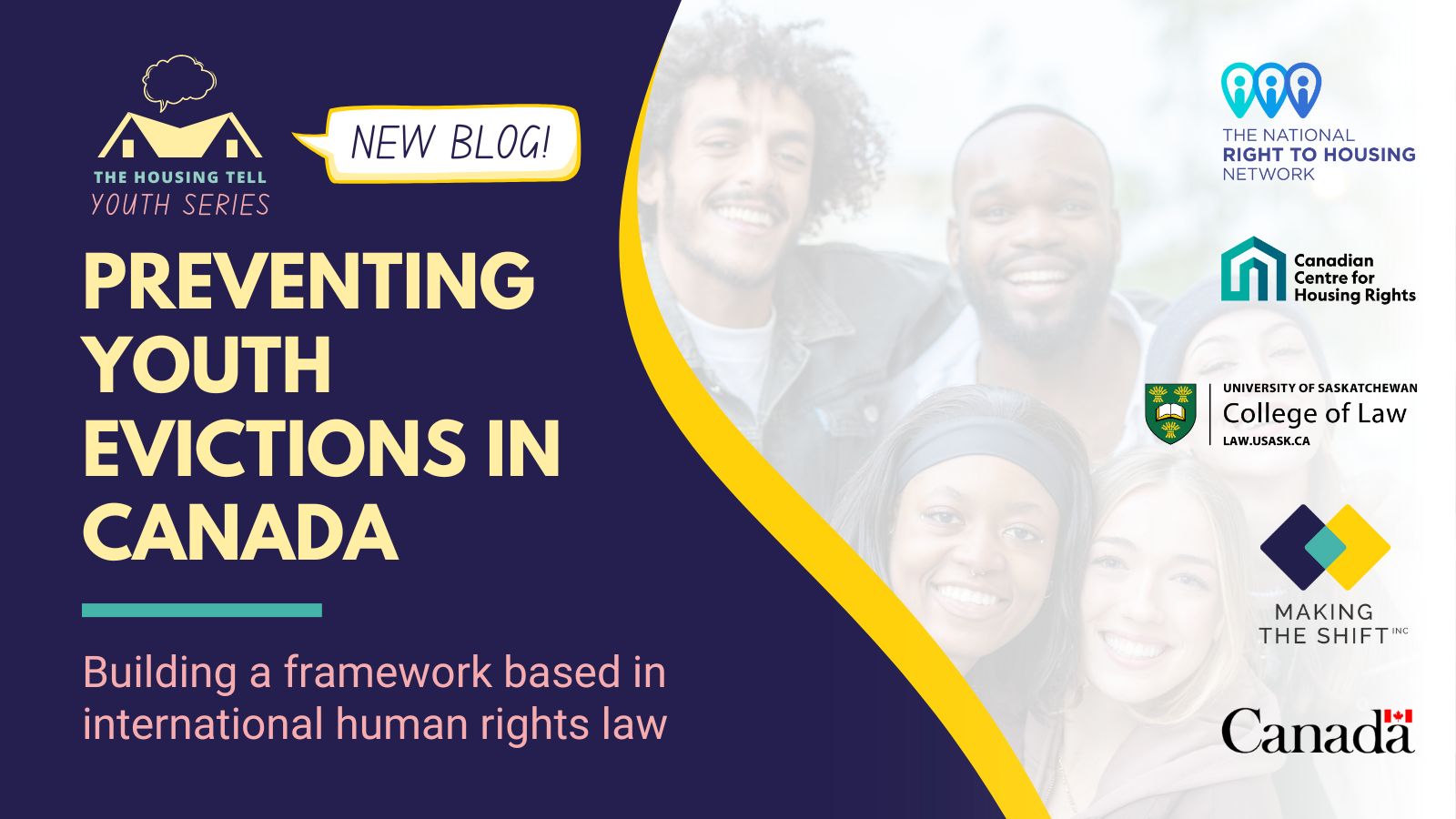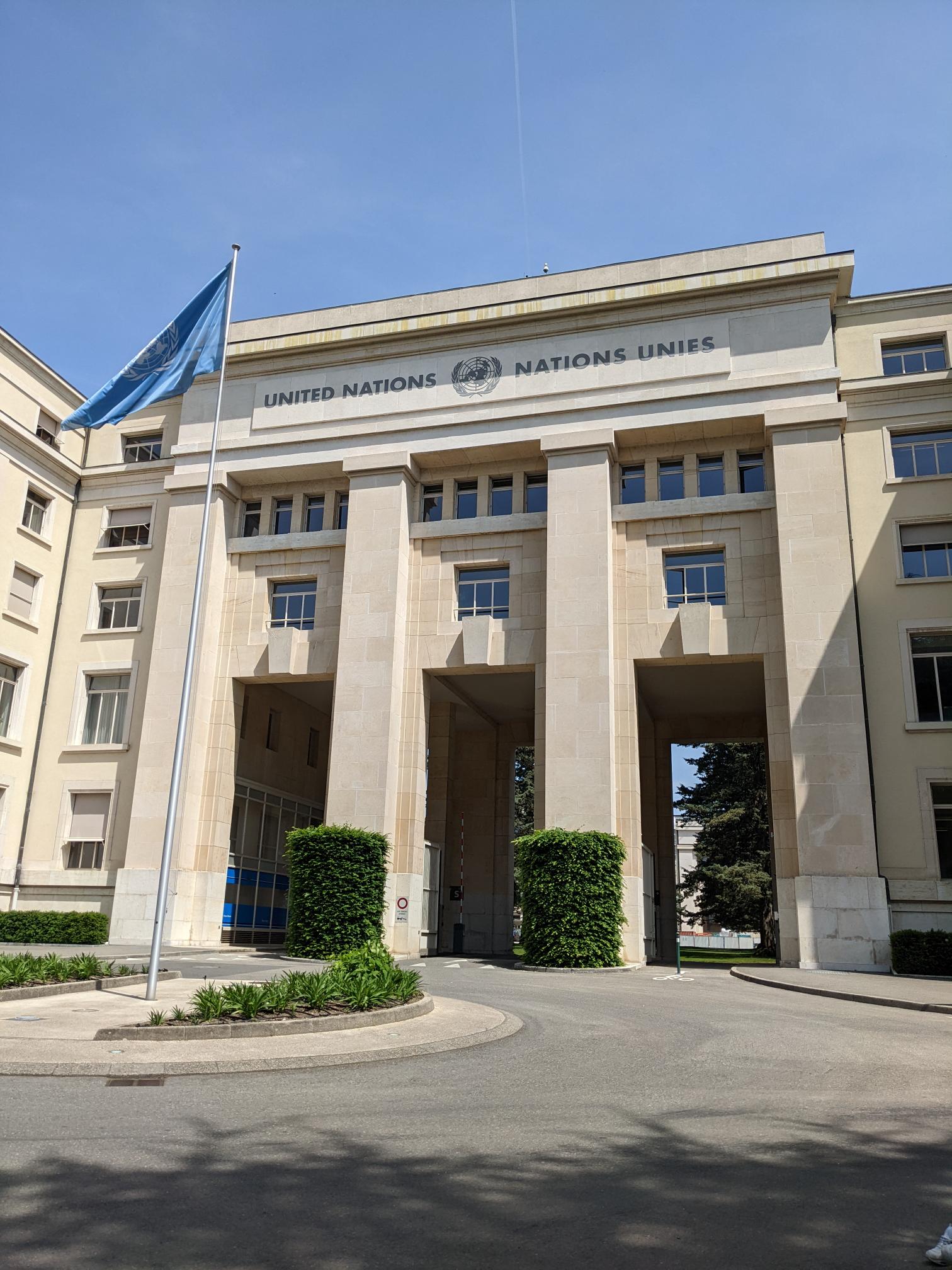If the right to housing does indeed exist for young people in Canada, where does that right live and what does it look like? What context can international human rights law and norms provide to unpack what the government’s obligations are in relation to eviction prevention for youth?
 On December 10th 2023, human rights advocates across the world celebrated the 75th anniversary of the United Nations Declaration on Human Rights (UDHR), the document that set out for the first time ever the foundation of human rights for all. It has been used to inspire more than 70 human rights treaties across the globe.
On December 10th 2023, human rights advocates across the world celebrated the 75th anniversary of the United Nations Declaration on Human Rights (UDHR), the document that set out for the first time ever the foundation of human rights for all. It has been used to inspire more than 70 human rights treaties across the globe.
One of the central human rights treaties that came out of the UDHR is the United Nations Convention on the Rights of the Child. In fact, it was just last year in 2022 that Canada was under the spotlight of the United Nations Committee on the Rights of the Child as they investigated how Canada was doing on implementing the human rights set out by this treaty. Under this treaty, protecting the rights of children and youth also means protecting their right to safe, accessible, adequate housing.
And yet, some of the most devastating human rights violations for children and youth in Canada occur in the context of their right to housing and the thunderous gaps in eviction law and policy that should be in place to prevent youth from experiencing housing insecurity and homelessness. Even though eviction into homelessness is a violation of international human rights law, Canadian eviction laws do not reflect these human rights obligations, nor do they account for the unique experiences and vulnerabilities of youth. Instead, tribunals too often function as “eviction machines.”
This is why, over the past year, the National Right to Housing Network, the Canadian Centre for Housing Rights, and Professor Sarah Buhler at the University of Saskatchewan have been working on a project exploring a human rights and youth-centred approach to eviction law and practice.
This blog is the first in a three-part blog series from this project, covering different critical intersections between youth eviction and the right to housing. This first piece focuses on the key questions: if the right to housing does indeed exist for young persons in Canada, where does that right live and what does it mean? What context can international human rights law and norms provide to unpack what the government’s obligations are in relation to eviction prevention for youth?
 This work is funded by Making the Shift Youth Homelessness Social Innovation Lab (MtS) where researchers and advocates are unpacking the reality that evictions are particularly damaging for youth because of their long-term consequences and propensity to entangle youth with other systems—for instance, the education, prison, healthcare, or child welfare systems that can either exacerbate housing insecurity for young people, or be pillars of prevention-based plans.
This work is funded by Making the Shift Youth Homelessness Social Innovation Lab (MtS) where researchers and advocates are unpacking the reality that evictions are particularly damaging for youth because of their long-term consequences and propensity to entangle youth with other systems—for instance, the education, prison, healthcare, or child welfare systems that can either exacerbate housing insecurity for young people, or be pillars of prevention-based plans.
Through research undertaken by a team of law students at University of Saskatchewan, engagement with youth, and testing of ideas for implementation with decision-makers, our research team is exploring in this project the fundamental question: can we build a youth-centred and human rights-informed approach to eviction law and practice that prioritizes eviction prevention?
The Backdrop of Youth Evictions in Canada
Every year, countless people living in Canada grapple with the grim reality of eviction into homelessness (i.e., eviction with no alternative housing immediately available), an event that propels an individual or a family into a spiral of social, economic, and psychological turmoil.
These types of evictions, whether due to non-payment of rent, redevelopment, or landlord-tenant disputes, trigger a host of social, economic, and human rights concerns which are acutely felt by the most vulnerable and marginalized populations, such as low-income families, single-parent households, immigrants, and people with disabilities, often exacerbating their existing disadvantages.
These severe, disproportionate impacts are especially true for young people, homeless youth, and those in precarious housing situations who often face the brunt of eviction-related issues at one of the most vulnerable times in their lives.
To better understand how international human rights laws and standards can be used as a foundation to protect young people from evictions, we must first look at how these international human rights standards inform the right to housing in Canada.
Where Does the Right to Housing Come From? 
International human rights law, with its rich array of norms, standards, and judicial interpretations, provides a valuable framework for understanding and addressing eviction practices. Canada also has enacted the National Housing Strategy Act (NHSA)—the country’s first piece of legislation recognizing housing as a fundamental human right.
The NHSA was critical for the right to housing movement in Canada because it presented an opportunity that brought home international human rights law to the Canadian domestic legal context. This is an important, fundamental context because in order to create solutions to youth evictions—particularly evictions that lead to homelessness—we need to first establish that the right to housing is enshrined in international human rights law.
Instruments from international human rights laws provide critical insights into security of tenure, the prohibition of forced evictions, and the need for adequate alternative housing. These instruments include:
- The International Covenant on Economic, Social, and Cultural Rights (ICESCR)
- The Committee on Economic, Social and Cultural Rights’ General Comment No. 7
- The United Nations Convention on the Rights of the Child
- Reports of the UN Special Rapporteur on the Right to Adequate Housing
- The Optional Protocol to the ICESCR
Let’s take a brief look at each of these instruments and see how they inform the right to housing in Canada:
1. International Covenant on Economic, Social, and Cultural Rights (ICESCR)
Canada ratified the International Covenant on Economic, Social, and Cultural Rights (ICESCR) in 1976, meaning that the government agreed to be bound by a treaty. To assess Canada’s compliance with that treaty, the country undergoes a review every five years or more. The Government of Canada and provincial/territorial governments will travel to the United Nations in Geneva, Switzerland to answer the questions of the members of a United Nations Committee on Economic, Social, and Cultural Rights (UNCESCR), and at the end of that process, the UNCESCR issues Concluding Observations.
At Canada’s last review, in 2016, the UNCESCR urged the federal government to “develop and effectively implement a human-rights based national strategy on housing and ensure that all provincial and territorial housing strategies are aligned with the national strategy.” They also recommended that Canada: “Regulate rental arrangements with a view to ensuring that tenants enjoy the right to affordable and decent housing and are not vulnerable to forced evictions or homelessness”; and that governments “ensure that its legislation on forced evictions is compatible with international norms, particularly with respect to its obligation to ensure that no persons find themselves homeless or victims of other human rights violations due to evictions, and that compensation or alternative accommodation is provided to victims.”
These themes of protection from forced evictions, as well as compensation or alternative accommodations being provided by the State (in this case governments of Canada), are further articulated in other international human rights instruments.
2. Committee on Economic, Social and Cultural Rights’ General Comment No. 7
The United Nations Committee on Economic, Social, and Cultural Rights similarly plays a role in developing “General Comments”—materials which clarify the reporting duties of the government that has signed onto the treaty—and importantly suggests approaches to implementing treaty provisions.
General Comment No. 7 outlines the state’s obligations particular to evictions and notes that “[e]victions should not result in individuals being rendered homeless or vulnerable to the violation of other human rights.”
The Committee further articulates that “[w]here those affected are unable to provide for themselves, the State party must take all appropriate measures, to the maximum of its available resources, to ensure that adequate alternative housing, resettlement or access to productive land, as the case may be, is available.”
This international human rights perspective allows for a comprehensive understanding of the implications of eviction practices on individuals and societies at large. It recognizes eviction as more than a mere contractual issue between a landlord and tenant, framing it instead as a potential infringement on the fundamental rights of an individual. It also underscores the role of the state as not merely a regulator of landlord-tenant relations, but as a guarantor of human rights.
 3. United Nations Convention on the Rights of the Child
3. United Nations Convention on the Rights of the Child
Critically, the State (Canada in this case) is required to ensure that alternate arrangements are available to ensure an eviction does not lead to homelessness—particularly in the context of marginalized groups. The United Nations Committee on the Rights of the Child is particularly salient on this point.
In 2022, Canada underwent a review based on the Convention on the Rights of the Child (CRC), which was ratified in 1991. In the Concluding Observations resulting from that review, the Committee recommended that Canada, “[c]onsider revising the provincial and territorial laws governing evictions to ensure that the best interests of the child are given primary consideration in all eviction matters and that all avenues for eviction prevention are pursued prior to termination of tenancy.”
The Convention on the Rights of the Child further includes provisions that underscore the rights of children to be heard, to have their best interests considered, to benefit from the highest attainable standard of health, and to have a standard of living adequate for their physical, mental, spiritual, moral, and social development.
|
A note on our project: It is important to note that this convention addresses children (up to age 18) and much of this project focus looks at youth above the age of 18. However, housing loss prevention and support for children and teens can provide critical buffers against eviction for youth over 18 by providing early interventions that can shape youth trajectory into homelessness and housing instability. It is important that in looking at youth experiences with evictions, we look “upstream” to identify and establish appropriate supports earlier in life. Our project distinctively focuses on youth as lease or tenure holders who are directly facing evictions, rather than children who are typically part of family units or attached to adults. This perspective, paired with a prevention lens, is crucial because it acknowledges the unique challenges and legal implications faced by young individuals who hold tenancy responsibilities. Understanding their experiences requires a different lens than that used for analyzing the impact of evictions on children in family contexts. Of course, we also recognize that youth over the age of 18 are sometimes themselves the parents of young children. |
4. Reports of the UN Special Rapporteur on the Right to Adequate Housing
Other human rights authorities are United Nations Special Rapporteurs—individual experts who are responsible for monitoring specific human rights, and who play a key role in interpreting the rights protected in Covenants like the Covenant on Economic, Social, and Cultural Rights and Convention on the Rights of the Child.
In 2019, the UN Special Rapporteur on the Right to Adequate Housing issued a thematic report with Guidelines for the Implementation of the Right to Adequate Housing.
In this report, the Special Rapporteur articulated that:
“National laws governing evictions must be compliant with human rights norms, including the principle of respect for human dignity and the general principles of reasonableness, proportionality and due process, and should equally apply to those living in homeless encampments. Access to justice must be ensured throughout the process and not just when eviction is imminent. All feasible alternatives to eviction must be explored, in consultation with affected persons. If, after meaningful engagement with those affected, relocation is deemed necessary and/or desired by the community, adequate alternative housing of similar size, quality and cost must be provided in close proximity to the original place of residence and source of livelihood. Evictions must not render people homeless.”
|
“Access to justice must be ensured throughout the process and not just when eviction is imminent” means that: 1) In instances of mortgage foreclosure or rent arrears, evictions should only occur as a last resort and after a full exploration of alternative means to resolve outstanding debt, such as through emergency housing benefits, debt rescheduling or, if required, relocation to more affordable housing units meeting adequacy standards; 2) States should implement programmes to prevent evictions through measures such as rent stabilization and controls, rental assistance, land reform and other initiatives to promote land and tenure security in urban and rural settings. Preventive measures should also be adopted to eliminate the underlying causes of eviction and displacement, such as speculation in land, real estate, and housing. No relocation of Indigenous peoples is permitted without their free, prior, and informed consent. |
5. Optional Protocol to the ICESCR
Canada has not signed onto the Optional Protocol to the International Covenant on Economic, Social, and Cultural Rights (ICESCR), but for those countries that have agreed to the Optional Protocol, there is a further mechanism by which rights holders can exercise rights protected by the Covenant.
We can learn from the decisions coming from the Optional Protocol process and apply them to the context in Canada, for example in a decision based on applicants from Spain where UN Committee member stated, “Through our decision we reaffirm that all people, including those who live in rented accommodation, have the right to housing. States have a duty to ensure that their evictions do not render them homeless.”
The Committee further added that, “States have an obligation, to the maximum of their available resources, to provide alternative housing to those evicted who are in need. It is for the State concerned to show that it took all the necessary steps but was unable to grant the evicted people with alternative housing.”
What Do These Human Rights Concepts Mean for Preventing Youth Evictions in Canada?
With the recent 75th anniversary of the Universal Declaration of Human Rights, there is no better time for all levels of government in Canada to reflect on the actions we are taking to implement human rights to prevent youth evictions—and we can use international human rights authorities to figure out what that means in practice. What we do know is that, for youth, it means ensuring evictions do not lead to homelessness—a phenomenon we know is happening all across the country.
Much more work needs to be done. In the coming months, look out for more information as we release further pieces exploring this topic. In early 2024, we will also be working directly with young people who have firsthand knowledge and experience of evictions. They will mobilize their experiences through action-oriented and community-driven workshops, where together, we will build alternative models and solutions to help prevent eviction for young people across Canada.
This work is funded by Making the Shift, a member of the Networks of Centres of Excellence Canada Program. Making the Shift is funded by the Government of Canada’s Networks of Centres of Excellence program. The opinions and interpretations in this publication are those of the author and do not necessarily reflect those of the Government of Canada.


